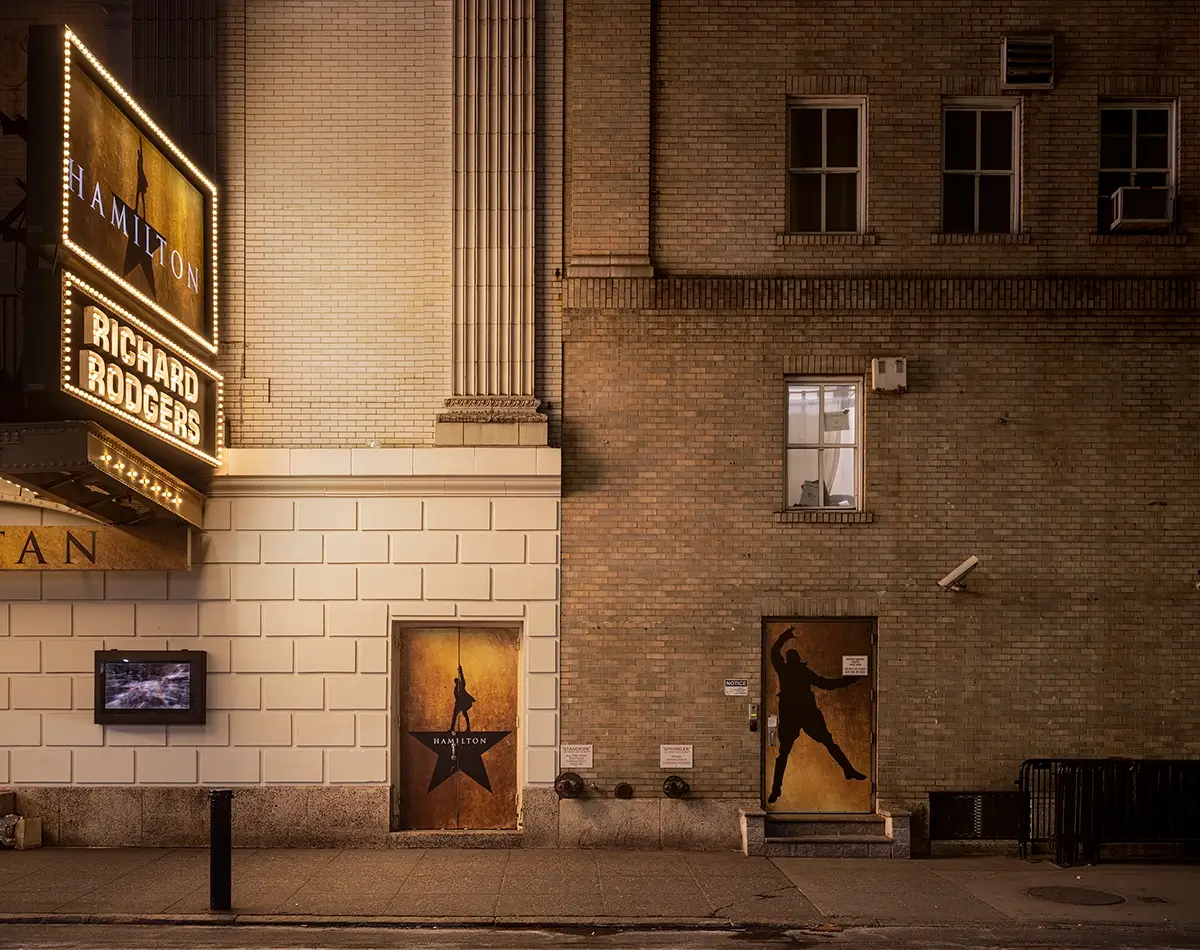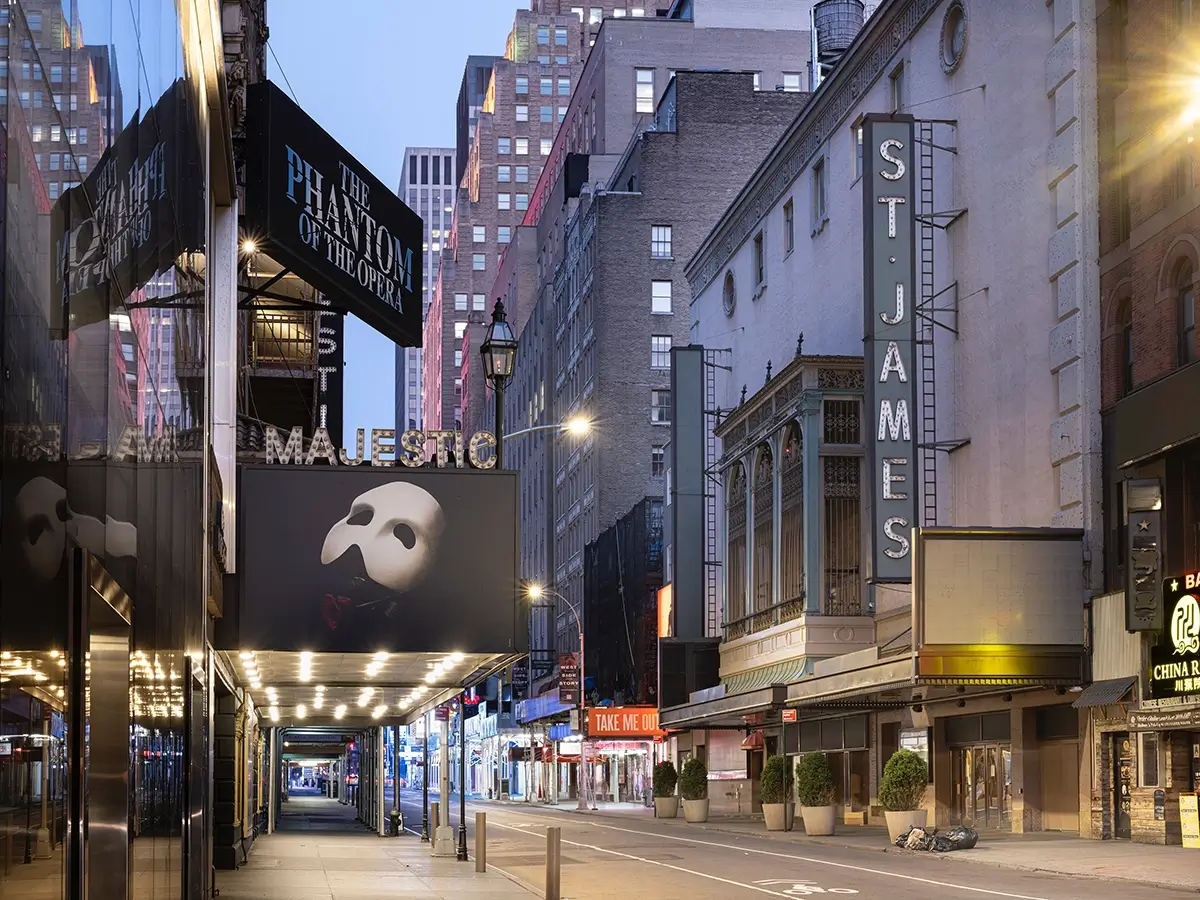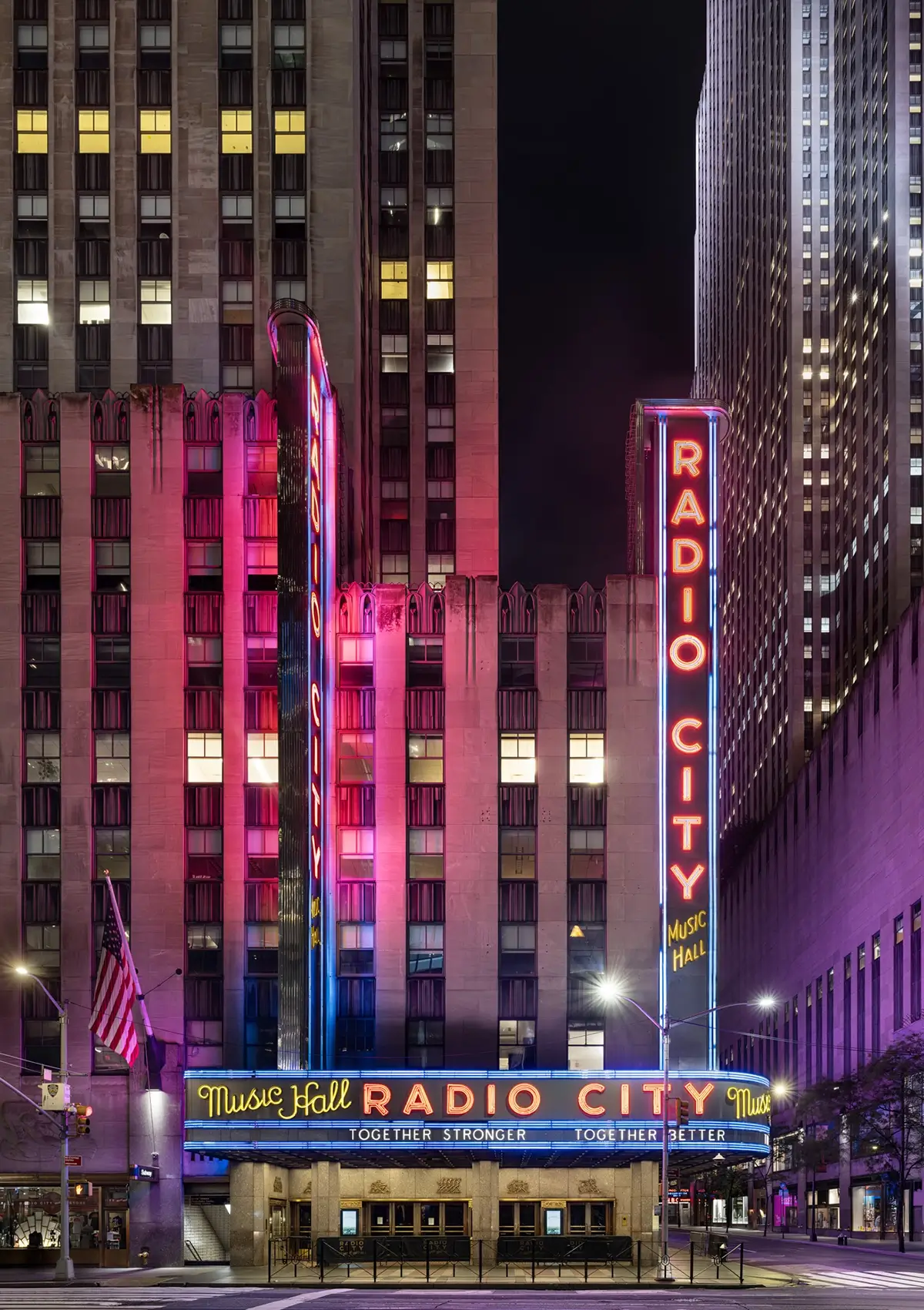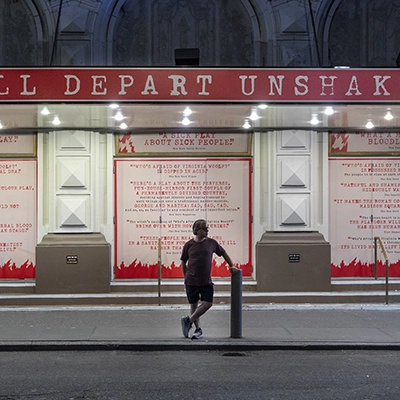Five years after Broadway’s Great Intermission,
Mark S. Kornbluth’s series DARK returns to AIPAD’s The Photography Show with
Cavalier Gallery. Capturing the haunting beauty of New York’s shuttered theaters during the pandemic, DARK is both a tribute to resilience and a testament to the enduring power of the arts. With new works debuting at his exhibition
ENCORE, we asked Mark a few questions about his life and work.
All About Photo: Tell us about your first introduction to photography.
Mark S. Kornbluth: I tried a lot of different mediums as a vehicle for expression, but I never really fell in love with or found complete communication with any of them. I’ve always had a quiet curiosity about what lies beneath the obvious. Perhaps that was what I was exploring with different art forms. As a kid, I remember sitting on the stairs outside the living room, and being fascinated by the mechanics of a 35mm camera I found on a shelf. I don’t think I even took my first photo until I was a freshman in college, when I took an elective course.
What started your career as a photographer?
I left my career as a stage manager and went back to school to study acting. Someone paid me to do a photo shoot, and someone else saw me getting paid. They asked if I was a professional, and I, of course, said yes. That yes is what got us here, to this moment.
As much as I try to resist this kind of magical thinking, this career path found me. Most of my
life COULD be defined as my trying to avoid the inevitable. Every time I’ve attempted to
develop another career, odd, usually big shifts, have happened in my life. These seismic
happenings have allowed me to continue to keep a roof over my head with my camera.
What initially drew you to photograph Broadway theaters during the pandemic, and how did the idea for DARK take shape?
I was bored with the life that the lockdown created, and disappointed in the photos of NYC that I was seeing on TV. Nothing really articulated the wonder and fortitude that NYC exudes. I ended up on Times Square for a number of reasons. My professional life in the theatre started there, and I seem to always return. Many of my friends still work in the theatre, and I was simply curious to experience Times Square when nobody else was there. Also, as we all hesitated to leave our homes for fear of death, it was a destination very close to where I was living. So, I started there for both deeply personal reasons, as well as convenience.
Once I arrived, I was struck by the language and narrative in the signage, and its poignant relevance, even with the stillness of the mise-en-scène. Despite that sudden and lasting emptiness that started in 2020, I was moved by an unexpected tension, a sense of Broadway waiting for the promise and renewal that art invariably brings. I have always been deeply curious about relationships between objects, how emotions are rooted in time and place, and how to create the power of a shared experience. I was alone, and I was motivated to make what I was witnessing known to others. Somehow, this was still a communal moment, worthy of the world to see.

Richard Rodgers Stage Door © Mark S. Kornbluth, Courtesy Cavalier Gallery
I’m also a trained actor. That’s something I pursued after I left my career as a stage manager. Photography picked up first, and any job in the arts demands a minimum of a full-time commitment. The thing about the stage management team is that we need to have a working knowledge of all aspects of a production, both technically and artistically. Once a show opens, everything that happens in and behind the proscenium is under the responsibility of the stage managers. Being able to see the gestalt of how every aspect ties together also informs how I look at a frame. Seeing all the individual parts, and how essential each one is within the final tableau.
You switched from a 35mm camera to a large-format digital one for this series. What impact did that have on your creative process and the final images?
The first time I found ‘true expression’ was as an undergraduate, when I was studying with Joel Sternfeld. A profoundly personal issue surfaced in my work. Joel mused about having me work in a larger film format, to slow down, but decided that it would interfere with the ‘discovery phase’ of my photography. That ‘phase’, using a 35mm camera, spanned my earliest fine art, commercial, documentary, and event photography career. It lasted for years, and that turned into decades.
Photographing the Broadway theatres started a new chapter in my life. It was my opportunity to finally explore working with a large format camera, but in 2020 it was digital, not film. My friend, David Michalek, said “I think … what Joel meant by ‘slowness’ was less about time and more suggestive of the deepening awareness that comes when the artist engages with a tool or a process that insists upon careful deliberation and might even be, to some degree, frustrating.”
I spend more time simply framing an image in this format than I might take to do one family portrait in Central Park with the smaller camera. This slowness allows for the creation of a more insightful photograph.
What emotions did you experience while capturing these empty theaters, and how did you translate those feelings into your work?
Wonder, awe, and curiosity. I think those feelings are at the root of every time I hit a shutter button, no matter what I’m photographing. My intention is to communicate how I’m captivated by a subject. Each project I work on has different technical and artistic obstacles in between that initial impulse / reaction to a scene or moment, and the final image before the viewer. One reason I moved to the large format cameras was to mitigate the shortcomings of night photography, including shallow depth of field, motion blur, and visual noise, and to reveal abundant details in the subject and environment, facilitating a deeper examination of the final image.

Lyric © Mark S. Kornbluth, Courtesy Cavalier Gallery
I would guess this is true about many professions, that when people work within a particular industry, it’s not as exciting from the inside as it is from the outside. But there is an allure, a mystique about the theatre; an electrical current that runs through the heart of everyone who participates. But we never really have a chance to stand back and look at the buildings we work in. They have their own life, their own character. A thing that continues to surprise me is the personal relationship I develop with each image I make; the memories of what I did to ‘find’ the final image. Some theatres, like The Ambassador, I photographed over a half dozen times. At many theatres I stood in the middle of the street, because there was no traffic. Each frame was its own project, had its own unique approach. Most projects I start begin with questions and curiosities more than a mission statement and cohesive thesis. I had no idea how beautiful any of the architecture was. I feel connected to every theatre in ways that are unique.
DARK has been described as both a tribute to Broadway and a symbol of New York’s resilience. What do you hope viewers take away from the series?
Each image, and the series, have deep personal meaning to me. I have been infatuated with New York City for decades. My hope is to communicate how I am captivated, and the emotions I feel ‘in real time.’ I invite my audience to view these images as I have come to see them, as windows through which memory and time work in both directions --we need only look a little closer to know we will someday return, together. Ansel Adams wrote: “A great photograph is a full expression of what one feels.” I hope people will take the time to explore these images and are also filled with the same wonder and awe that I am when wandering the city streets.
How have theater professionals and New Yorkers reacted to your work? Any memorable responses?
The resounding enthusiasm has been overwhelming. My friend Mary-Louise Parker wrote an amazing essay about the work, for the show catalog. It was quite a gift. I wasn’t the only one who had no idea how amazing the architecture was, and many people were surprised at the beauty, not only of the buildings themselves, but how they blended into their surroundings. New York City usually moves so fast, we don’t have time to stop and look up.

Majestic & St James © Mark S. Kornbluth, Courtesy Cavalier Gallery
When leaving the theatre at night, we turn on one ‘ghost light’ on the stage. It is a single, bare bulb left burning when the theatre is otherwise dark and unoccupied. A light for safety, and to ensure good luck by always having the stage illuminated. All of Broadway became a safety light to the world. Without figures, the photos convey volumes about our interdependence; the contributions of immigrants, tourists and locals, informing a cultural and economic landscape. Theatre is the spine of Times Square, a beacon, and as a result, Times Square is where the world meets by accident and intention. Broadway’s lights pull people in, but it's the workers, vendors, and artists—the ones feeding off and feeding into that energy—who turn the glow into gravity. The industries built on those footsteps are multiplying, layer by layer, proof that this isn’t just a place people visit—it’s one they keep alive.
Can you tell us about ENCORE and what makes these new images distinct from the original DARK series?
ENCORE includes images from the DARK series that have never been published or exhibited before. I’ve also released a photograph of Radio City Music Hall, just steps away from Broadway. The marquee at the theatre reads ‘together stronger, together better.’ This message resonates on personal, professional, and political levels. While the creation of each image was like a meditation, there was nonetheless an urgency to document the many aspects of New York City beyond Times Square. There are so many things I love about NYC; I couldn’t list them in a novel. Quiet, strong, resilient, patient, a beacon of hope; teacher of acceptance, a place to learn that our strengths lay in our differences, that we are all equal. There is a place for everyone in New York City. I think of Times Square as the heart of New York City. From time to time, I have the luxury of looking back to discover, not only what I missed when I was out shooting, but also what I missed in the edit. The newest theatres help build this message of fortitude.
With this project revisiting such a historic moment, do you see yourself continuing to explore Broadway or shifting focus to other cultural spaces?
The series started during a historical moment, but I don’t think of the work as being about that time in the world. I had a unique opportunity to explore one icon of New York City. As Times Square became populated again, I worked in concentric circles, outwards, wandering the streets of New York City. I continue to do that now, and plan to do that for the foreseeable future. Most of my projects germinate for months, sometimes, years. It’s fun, when I go back and edit from the archives, to see the seeds and first images of something I’ve been working on for a while. And by working, I mean both the act of photographing, as well as the unconscious process of genesis and germination of locations. I’ll admit, I was spoiled five years ago. I had Times Square to myself. This is how empty it was: I could leave my camera, cross the street, and then stroll back. I was a bit upset when it got crowded again… strangers in my backyard, partygoers too drunk to help clean up before they leave. I’m not a methodical person, I jump from ‘space to space,’ project to project, and back again. Nothing’s ever really finished. I am actively looking at how to tell the next chapter of Times Square. Accretion is the central identity of New York, so by definition there is no option but to continue telling that story.
Are there any new projects or themes you’re excited to explore in the future?
Always. One great gift of being associated with the arts is that it’s a constant education. When I’m not shooting, I’m editing, when I’m not editing, I’m researching. By research I mean going to museums and galleries, having in depth conversations with other artists, reading, Googling… Under the umbrella of “The Street,” I’m developing several themes of unnoticed but enduring symbols of New York City. It’s my habit not to reveal specifics until the work is ready to go, but I’m quite excited about the work that I’m currently developing.

6th and 50th Street © Mark S. Kornbluth, Courtesy Cavalier Gallery





